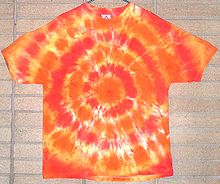
Back Knoop-en-doop Afrikaans صباغة قماش مربوط Arabic Tie-dye Spanish رنگرزی گرهی Persian Teinture par nouage French Tie-dye HE Ikat celup ID Nodo-tinto IO 絞り染め Japanese Tie-dye Dutch

Tie-dye is a term used to describe a number of resist dyeing techniques and the resulting dyed products of these processes. The process of tie-dye typically consists of folding, twisting, pleating, or crumpling fabric or a garment, before binding with string or rubber bands, followed by the application of dye or dyes.[1] The manipulations of the fabric before the application of dye are called resists, as they partially or completely prevent ('resist') the applied dye from coloring the fabric. More sophisticated tie-dye may involve additional steps, including an initial application of dye before the resist, multiple sequential dyeing and resist steps, and the use of other types of resists (stitching, stencils) and discharge.
Unlike regular resist-dyeing techniques, modern tie-dye is characterized by the use of bright, saturated primary colors and bold patterns. These patterns, including the spiral, mandala, and peace sign, and the use of multiple bold colors, have become clichéd to become symbols of the counterculture movement of the 1960s. However tie dye wasn't as pronounced in fashion even among the counterculture as it would be in later years and the present day. The vast majority of tie-dye garments and objects produced for wholesale distribution use these designs, with many being mass-produced.
In the 21st century, a revived interest in more 'sophisticated' tie-dye techniques emerged in the fashion and hobby industry, characterized by simple motifs, monochromatic color schemes, a focus on fashionable garments and fabrics other than cotton,[2] and the pursuit of tie-dye as an art form, rather than a commodity.
- ^ "Textile Terms". The George Washington University. Retrieved 10 May 2022.
- ^ Ebert, Erin. "Sense Of Fashion: Tie-dye gets modern". Savanna Now. Morris Publishing, Inc. Archived from the original on 3 December 2013. Retrieved 16 November 2013.
© MMXXIII Rich X Search. We shall prevail. All rights reserved. Rich X Search